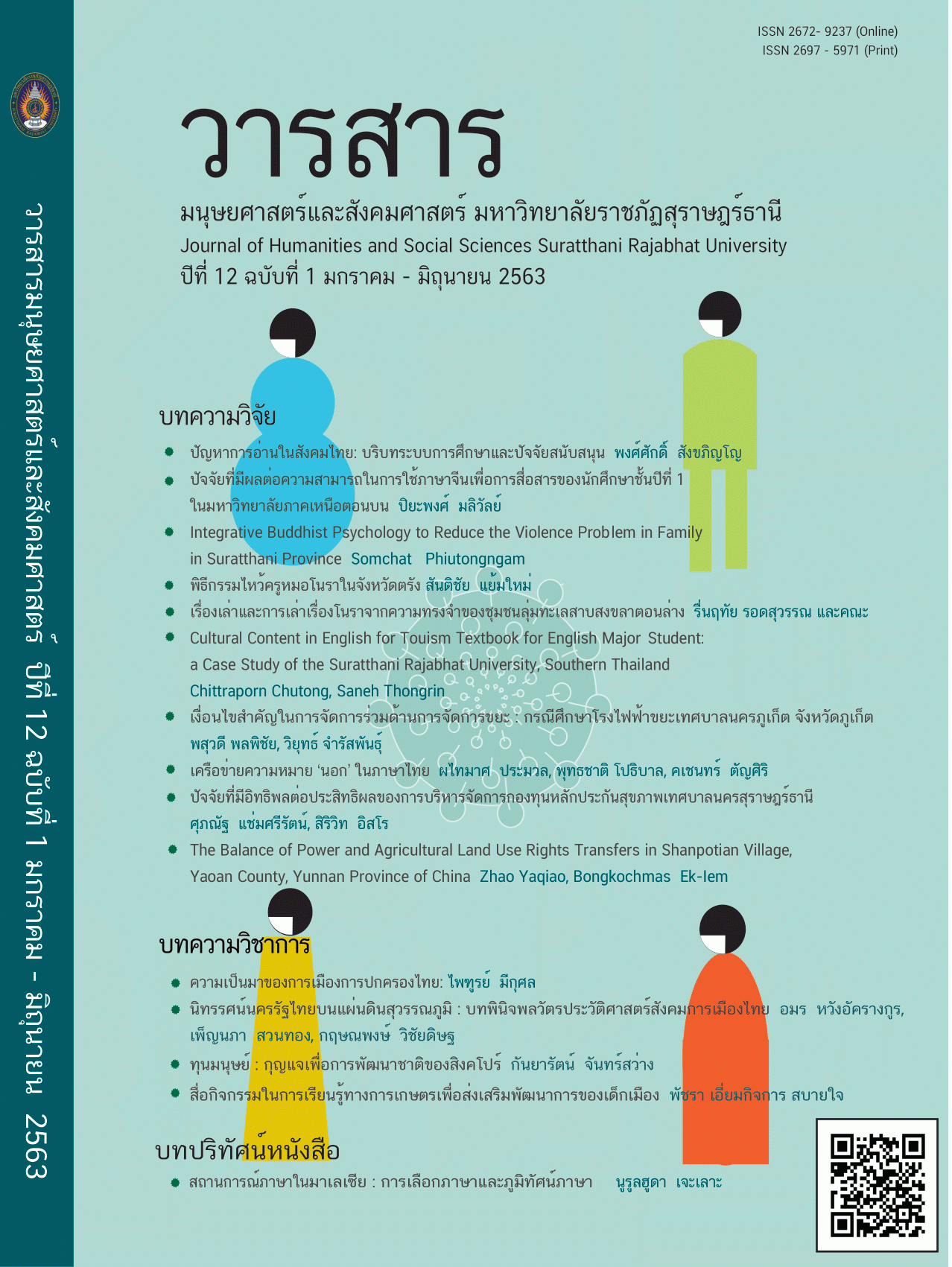The story of the Thai Politics and Government
Main Article Content
Abstract
The article aims to study the story of Thai politics from the past to the present and the results of contemporary Thai politics under theconcepts of Buddhism, Brahma - Hinduism, and local traditional beliefsunder the method of historical approach. The primary andsecondary
sources from the works of historians and historical philosophers wereemployed. The descriptive analysis was presented.The results of study are as follows: regarding the Thai politics in the past, theoretically, the king was the top of the hierarchy of the absolute monarch in the kingdom, successively from the Paternal government on the traditional beliefs, Dhamma Raja on the beliefs of Buddhism to Deva-Raja on the beliefs of Brahma-Hinduism in the form of integration. The previous kings appointed the Akkramahasenabodi Samuhanayok-Priminister for the civil, and the Akramahasenabodi Samuha Phra Kalahom - Priminister of the South for the military. Below these ranks came the Senabodi Chatusadom: the Ministry of the Metropolis (Wiang), the Minister of the Palace (Wang), the Minister of Finance (Klang), and the Ministry of Agriculture (Na). For theprovincial administration, the territory of the Kingdom was divided into three administrative categories: the inner provinces, the outer provinces, and the tributary states. In the early Bangkok period (King Rama 1-3), the Krommatha, dealt with foreign affairs at a time when overseas trading was largelyimportant and supposed to administer their provinces around the Inner Gulf of Thailand, which was as important as the Mahatthai Administer the North territory and Phra Kalohom Administer the South territory. The reforms were implemented in the reign of King Chulalonkorn in 1892 (2435 B.E.), thecentral administration has changed to twelve ministries, the ProvincialAdministration - the Thesaphiban system of administration and the local administration -Sukhaphiban. The reforms in the central government, the Thesaphiban System of Provincial Administration and Local Administration were implemented and developed to cover the entire country and brought it to the new modern nation – state. In the reign of King Prajadhipok (King Rama VII), the Thai politics changed from an Absolute monarchy to the Democracy in 1932 (2475 B.E.)However, the government administration following 1932 (2475 B.E.), had conflicts between the Kana Ratsadon (the people’s Party) and the
Government. Consequently the Military Leader first overthrow the government (coup d’etat) in 1933 (2476 B.E.). The conflicts in politics and economics were the main points to the overthrow of the governments for twenty-two times from the past to the present. Finally, the revolution on 22 of May 2014 (2557), caused by the capitalists and the richest politicians, has brought about the present crisis in Thailand.
Article Details

This work is licensed under a Creative Commons Attribution-NonCommercial-NoDerivatives 4.0 International License.
All published manuscripts have been verified by peer-peer professors in the fields of humanities and social sciences. Reprinting of the article must be authorized by the editorial staff.
References
กรมศิลปากร. (2510). เจ้านายและข้าราชการกราบบังคมทูลความเห็นจัดการ
เปลี่ยนแปลงราชการแผ่นดิน ร.ศ. 103 และพระราชดำรัสในพระบาทสมเด็จ
พระจุลจอมเกล้าเจ้าอยู่หัวทรงแถลงพระบรมราชาธิบายแก้ไขการปกครองแผ่นดิน.
พิมพ์ในงานฌาปนกิจศพหม่อมสนิท กฤษดา กร ณ เมรวัดธาตุทอง 6 มีนาคม
โกวิทย์ วงศ์สุรวัฒน์. (2562). ยุทธศาสตร์ชาติ 20 ปีอีกที. ใน มติชนรายวัน 26
สิงหาคม 2562. น. 16.
ชัยอนันต์ สมุทวณิชและขัตติยา กรรณสูต (บรรณาธิการ). (2518). เอกสารการเมืองการ
ปกครองไทย พ.ศ. 2417 - 2477. กรุงเทพฯ : สมาคมสังคมศาสตร์แห่ง
ประเทศไทย.
เตช บุนนาค. (2548). การปกครองระบบเทศาภิบาลของประเทศสยาม พ.ศ. 2435 –
กรุงเทพฯ : มหาวิทยาลัยธรรมศาสตร์.
นิธิ เอียวศรีวงศ์. (2562). มองการเมืองไทยผ่านกรัมชี่. ใน มติชนรายวัน 16
มิถุนายน 2557, น.15.
ประเสริฐ ณ นคร. (2547). การอธิบายศิลาจารึกสมัยสุโขทัย. โครงการกิตติเมธีสาขาวิชา
ศิลปศาสตร์ มหาวิทยาลัยสุโขทัยธรรมาธิราช.
.(2549). ประวัติศาสตร์เบ็ตเตล็ด รวมบทนิพนธ์ “เสาหลักทางวิชาการ ของ
ศาสตราจารย์ ดร. ประเสริฐ ณ นคร. กรุงเทพฯ : มติชน.
ปรัชญา เวสารัชช์. (2548). สังคมไทยในสังคมโลกก่อน พ.ศ. 2475 ใน ไทยกับสังคมโลก.
สาขาวิชาศิลปศาสตร์ มหาวิทยาลัยสุโขทัยธรรมาธิราช.
สำนักพิมพ์ต้นฉบับ. (2550). พระราชพงศาวดารกรุงเก่า ฉบับหลวงประเสริฐอักษรนิติ์ฯ.
กรุงเทพฯ : แปลนพริ้นติ้ง จำกัด.
ไพฑูรย์ มีกุศล. (2515). การปฏิรูปการปกครองมณฑลอีสานสมัยที่พระเจ้าบรมวงศ์เธอ
กรมหลวงสรรพสิทธิประสงค์ทรงเป็นข้าหลวงใหญ่ พ.ศ. 2436 – 2453.
ปริญญานิพนธ์การศึกษามหาบัณฑิต (สาขาประวัติศาสตร์) วิทยาลัยวิชาการ
ศึกษาประสานมิตร 30 สิงหาคม 2515.
ไพฑูรย์ มีกุศล. (2528). ประวัติศาสตร์ไทยสมัยต้น. มหาวิทยาลัยศรีนครินทรวิโรฒ
มหาสารคาม.
ไพฑูรย์ มีกุศล. (2542). “จตุรพักตร์พิมาน, เมือง” ใน สารานุกรมวัฒนธรรมไทย ภาคอีสาน
เล่ม 3. จัดพิมพ์เนื่องในพระราชพิธีมหามงคลเฉลิมพระชนมพรรษา 6 รอบ 5
ธันวาคม 2542.
ไพฑูรย์ มีกุศล. (2545). แนวคิดแนวทางในการศึกษาสังคมและประวัติศาสตร์. กรุงเทพฯ :
จตุพรดีไซน์”
พลตรี หม่อมราชวงศ์ศุภวัฒย์ เกษมศรี. (2556). การศึกษาประวัติศาสตร์ไทยเชิง
วิเคราะห์ : สถาบันพระมหากษัตริย์ในบริบทสังคมไทย. ปาฐกถาชุด “สิรินธร”
ครั้งที่ 28 กรุงเทพฯ : โรงพิมพ์แห่งจุฬาลงกรณ์มหาวิทยาลัย.
ณัฐวุฒิ สุทธิสงคราม. (2504). สมเด็จเจ้าพระยาบรมมหาศรีสุริยวงศ์. พระนคร :
โรงพิมพ์เทพไพศาล.
หอสมุดแห่งชาติ. (2513). ราชพงศาวดารกรุงกัมพูชา. พระนคร ; แพร่พิทยา.
หม่อมอมรวงศ์วิจิตร (ม.ร.ว. ปฐม คเณจร). (2506). “พงศาวดารมณฑลหัวเมืองอีสาน”
ใน ประชุมพงศาวดาร ภาค 4 เล่ม 3, องค์การค้าของคุรุสภา.
วีณา มโนพิโมกษ์. (2520). ความขัดแย้งภายในคณะราษฎร. วิทยานิพนธ์อักษรศาสตร
มหาบัณฑิต คณะอักษรศาสตร์ จุฬาลงกรณ์มหาวิทยาลัย.
สุมาลี บำรุงสุข. (2545). “การเผชิญกับจักรวรรดินิยมและการปรับปรุงบ้านเมือง”
ใน ประวัติศาสตร์ไทย หน่วยที่ 7. สาขาวิชาศิลปศาสตร์ มหาวิทยาลัย
สุโขทัยธรรมาธิราช.


